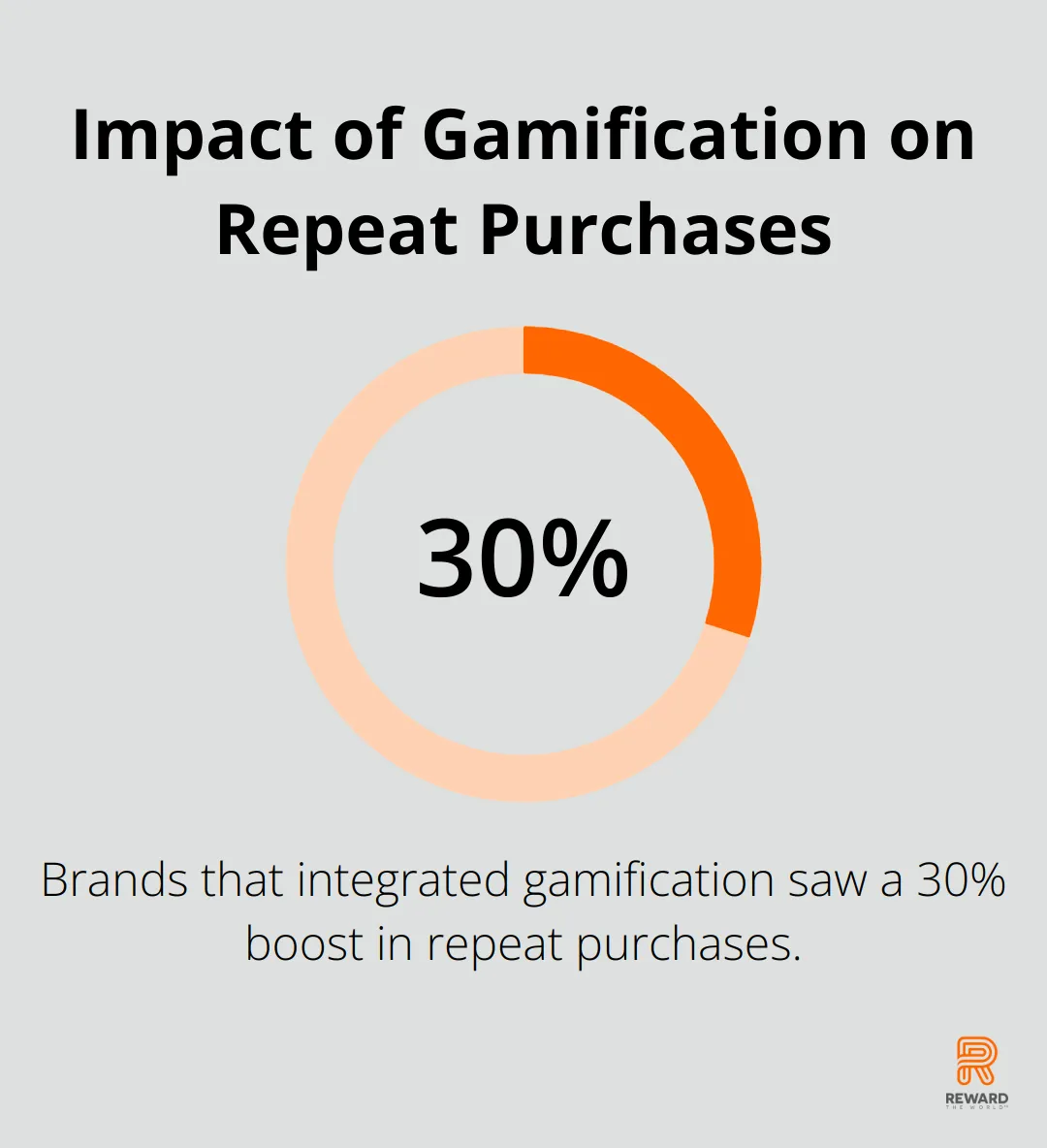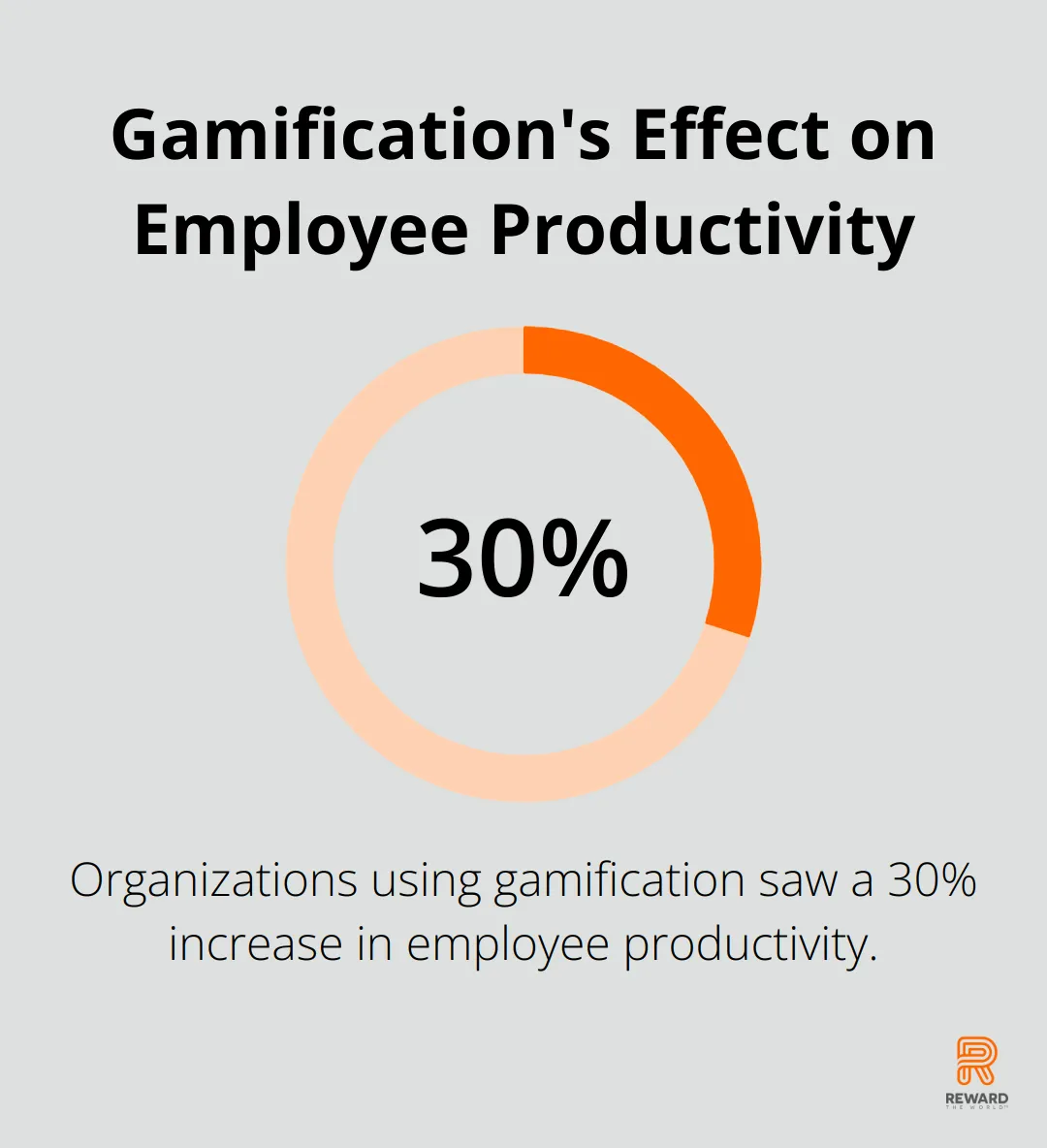
Gamification has become a popular strategy for businesses looking to boost engagement and productivity. But how do you know if your gamification efforts are actually working?
At Reward the World, we’ve seen firsthand the impact of well-implemented gamification strategies. In this post, we’ll explore key gamification metrics and how to measure the success of your initiatives.
How to Measure Gamification Success
Engagement Metrics: The Core of Gamification
Engagement forms the foundation of successful gamification. Companies should track metrics such as daily active users (DAU), time spent on the platform, and interaction frequency. Research shows that concentrating on employee engagement can help companies withstand — and possibly even thrive — in tough economic times. These metrics help assess the impact of gamification on user engagement when compared to pre-implementation data.
Performance Indicators: Connecting Gamification to Business Objectives
Effective gamification aligns with overall business goals. For sales-focused initiatives, track conversion rates, average order value, and customer lifetime value. Employee productivity measures include task completion rates and work quality. Research suggests that gamification can increase work engagement by providing employees with a sense of autonomy, competence, and relatedness.

User Progression and Achievement Tracking
Monitor user advancement through your gamified system. Track challenge completion rates, badge acquisitions, and leaderboard movements. These metrics offer insights into user motivation and reward structure effectiveness. A study suggests that gamification can effectively improve the attitude of undergraduate students of medical sciences towards learning statistics.
Tools for Tracking Gamification Metrics
Analytics platforms prove invaluable for data collection and interpretation. Google Analytics tracks user behavior on websites or apps. For specialized needs, platforms like Badgeville provide comprehensive gamification analytics. Some companies offer robust analytics suites with real-time insights into user engagement and reward redemption patterns.
Continuous Evaluation and Optimization
Consistent metric review and comparison against pre-gamification baselines help identify trends. This data-driven approach enables informed decisions to optimize gamification strategies. Regular assessment ensures that gamification efforts remain aligned with evolving business needs and user preferences.
As we explore the effectiveness of gamification initiatives, it’s equally important to understand potential pitfalls that can hinder success. Let’s examine common mistakes in gamification implementation and how to avoid them.
Why Do Gamification Efforts Fail?
Misaligned Incentives: The Extrinsic vs. Intrinsic Balance
Many gamification efforts falter due to an overemphasis on extrinsic rewards. While points, badges, and leaderboards can provide short-term motivation, they often fall short in sustaining long-term engagement. A University of Rochester study highlights that intrinsic motivation and its effects on students’ perceived competence, autonomy, and relatedness prove far more potent for enduring engagement.
To avoid this pitfall, companies should design gamification systems that tap into users’ intrinsic motivations. This approach might involve creating challenges that foster mastery, autonomy, or a sense of purpose. For instance, a sales team could find more motivation in a system that tracks personal growth and skill development rather than focusing solely on raw numbers.
Poor User Experience: The Engagement Killer
Even well-intentioned gamification efforts can flop if the user experience lacks quality. A clunky interface, confusing rules, or overly complex systems frustrate users and lead to disengagement. Gartner reports that gamified applications will fail to meet business objectives primarily due to poor design.
To sidestep this issue, companies should invest time in user testing and iterative design. Gamification elements must integrate seamlessly into existing workflows and remain intuitive. A/B testing can help refine the approach. The ultimate goal should always be to enhance the user experience, not complicate it.
Misalignment with Business Goals: The Strategic Disconnect
Implementing gamification without clear business objectives often results in failure. This disconnect can render gamification efforts ineffective and potentially counterproductive.
Before launching any gamification strategy, organizations must clearly define what success looks like. Whether it’s increased sales, improved customer retention, or better employee performance, each gamification element should directly support these goals. For example, if the aim is to improve customer service, a points system that rewards employees for positive customer feedback (rather than just call volume) ensures that gamification drives meaningful results, not just superficial engagement.
Lack of Personalization: One Size Doesn’t Fit All
Gamification efforts often stumble when they adopt a one-size-fits-all approach. Different users have varying motivations, skill levels, and preferences. A system that fails to account for these differences may engage some users while alienating others.
To address this, companies should strive for personalized gamification experiences. This might involve offering different types of challenges or rewards based on user preferences or adapting the difficulty level to match individual skill levels. Platforms like Reward the World excel in this area, offering customizable reward options that cater to diverse demographics and preferences.
Neglecting Long-Term Sustainability: The Novelty Trap
Many gamification efforts start strong but lose steam over time. The initial excitement wears off, and users become bored or disengaged. This “novelty trap” often stems from a lack of long-term planning and ongoing development.
To maintain engagement, gamification systems must evolve. This evolution involves regularly introducing new challenges, updating reward structures, and incorporating user feedback. Companies should view gamification as an ongoing process rather than a one-time implementation. Regular analysis of user data and behavior can inform these updates, ensuring the system remains fresh and engaging.
As we explore these common pitfalls, it becomes clear that successful gamification requires careful planning, user-centric design, and ongoing optimization. In the next section, we’ll examine strategies to maximize the return on investment (ROI) from your gamification efforts, turning these potential pitfalls into opportunities for success.
How to Maximize ROI from Gamification
Personalize Gamification Experiences
One-size-fits-all gamification rarely yields optimal results. Companies should create personalized experiences that resonate with different user segments. Brands that have integrated gamification have seen engagement increase and boost repeat purchases by 30%.

Data analytics help understand user preferences and behaviors. Companies can segment their audience based on factors like age, skill level, or job role. They can then tailor challenges, rewards, and progression paths to each segment. For example, a sales team might benefit from different gamification elements than a customer service department.
Reward the World offers customizable reward options that cater to diverse demographics and preferences. This level of personalization ensures that each user finds value in the gamified experience, which drives higher engagement and better ROI.
Integrate Seamlessly with Existing Systems
Gamification must integrate smoothly with existing workflows and systems to truly drive results. Thanks to the growing adoption of digital transformation, the market has benefited from improved customer experiences and satisfaction.
Companies should identify key touchpoints where gamification can enhance existing processes. For a customer loyalty program, this might mean integrating gamified elements into the purchasing process or mobile app. For employee engagement, gamification can complement performance management systems.
Data should flow seamlessly between the gamification platform and other business tools. This integration allows for more accurate tracking of KPIs and enables real-time adjustments to the gamification strategy.
Improve Continuously Through Data-Driven Iteration
Successful gamification requires ongoing analysis and refinement to maintain engagement and drive results. Organizations using gamification saw a 30% boost in productivity among employees, significantly improving knowledge retention.

Companies should implement robust analytics tools to track key metrics such as user engagement, task completion rates, and business outcomes. They should review this data regularly to identify trends and areas for improvement. User surveys or focus groups can gather qualitative feedback on the gamified experience.
A/B testing helps experiment with different game mechanics, reward structures, or user interfaces. For instance, companies can test whether a leaderboard or a progress bar drives more engagement for a specific task. They can apply the insights gained from these tests to refine their gamification strategy continuously.
User needs and preferences evolve over time. What works today may not be as effective six months from now. Companies should stay attuned to changes in user behavior and adapt their gamification approach accordingly.
Align Gamification with Business Objectives
Effective gamification aligns closely with overall business goals. Companies should define clear objectives before implementing any gamification strategy. These objectives might include increased sales, improved customer retention, or enhanced employee performance.
Each gamification element should directly support these goals. For example, if the aim is to improve customer service, a points system that rewards employees for positive customer feedback (rather than just call volume) ensures that gamification drives meaningful results, not just superficial engagement.
Regular evaluation of how gamification efforts contribute to business objectives allows companies to adjust their strategies for maximum impact. This approach ensures that gamification remains a valuable tool for driving business success, rather than just a trendy add-on.
Final Thoughts
Effective gamification boosts engagement, productivity, and business outcomes. Companies must plan carefully, implement thoughtfully, and optimize continuously to succeed. Gamification metrics provide valuable insights into user engagement, performance improvements, and overall strategy effectiveness.
Companies should create personalized experiences that tap into intrinsic motivations and integrate seamlessly with existing systems. Regular data analysis, user feedback collection, and iterative refinement ensure that gamification strategies remain effective and aligned with evolving business needs.
Reward the World offers instant reward delivery, seamless integration, and robust analytics to help businesses create engaging gamified experiences. Our platform can help companies harness the power of gamification to drive engagement, boost performance, and achieve their business objectives (while avoiding common pitfalls).
